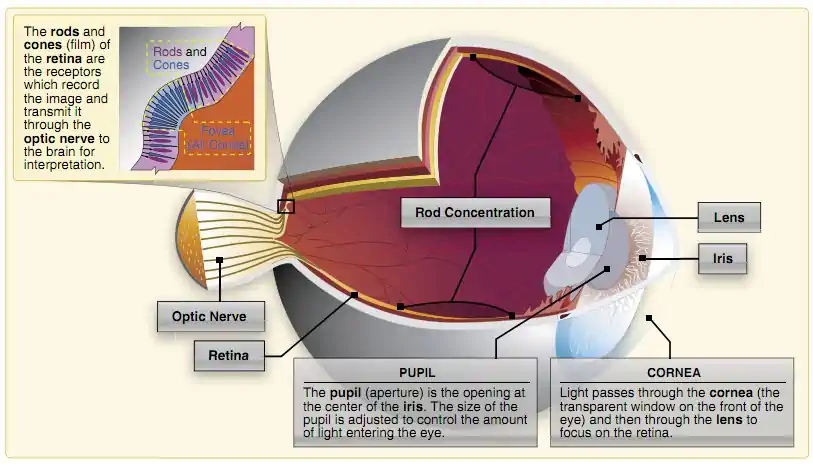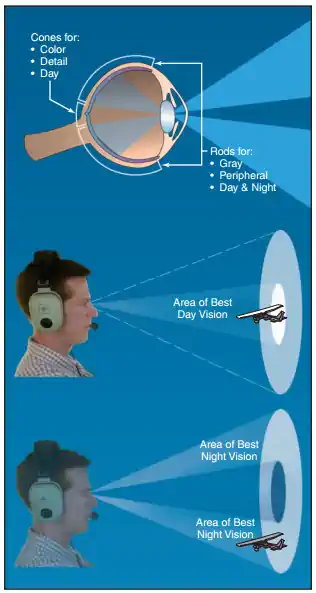WARNING:
All aeromedical topics are GENERALIZED.
Always consult with a doctor or physician to understand your specific situation
The Eyeball:
- Light enters through the cornea at the front of the eye
- The light then continues through the pupil which adjusts the amount of light which is allowed to enter the eye
- It travels through the lens where it is focused onto the retina
- The retina takes the light and through cells, converts light energy into electrical impulses for the brain
- A blind spot is located where the fovea attaches to the retina
- Beware of parallax error when attempting to read needles or trim the ball, etc.
Vision in Flight:
- Major factors that determine how effectively vision can be used are the level of illumination and the technique of scanning the sky for other aircraft
Vision Under Dim and Bright Illumination:
- Under conditions of dim illumination, small print and colors on aeronautical charts and aircraft instruments become unreadable unless adequate cockpit lighting is available. Moreover, another aircraft must be much closer to be seen unless its navigation lights are on
- In darkness, vision becomes more sensitive to light, a process called dark adaptation. Although exposure to total darkness for at least 30 minutes is required for complete dark adaptation, a pilot can achieve a moderate degree of dark adaptation within 20 minutes under dim red cockpit lighting. Since red light severely distorts colors, especially on aeronautical charts, and can cause serious difficulty in focusing the eyes on objects inside the aircraft, its use is advisable only where optimum outside night vision capability is necessary. Even so, white cockpit lighting must be available when needed for map and instrument reading, especially under IFR conditions. Dark adaptation is impaired by exposure to cabin pressure altitudes above 5,000 feet, carbon monoxide inhaled in smoking and from exhaust fumes, deficiency of Vitamin A in the diet, and by prolonged exposure to bright sunlight. Since any degree of dark adaptation is lost within a few seconds of viewing a bright light, a pilot should close one eye when using a light to preserve some degree of night vision
- Excessive illumination, especially from light reflected off the canopy, surfaces inside the aircraft, clouds, water, snow, and desert terrain, can produce glare, with uncomfortable squinting, watering of the eyes, and even temporary blindness. Sunglasses for protection from glare should absorb at least 85 percent of visible light (15 percent transmittance) and all colors equally (neutral transmittance), with negligible image distortion from refractive and prismatic errors
Visual Scanning:
- The eye can better see motion
- Keep the eye constantly scanning where you believe an object is located
- Good eyesight depends upon physical condition
- See more at the visual scanning and collision avoidance page
Night Vision:
- The difference between night and day vision are cones and rods [Figure 2]
- Both are located at the back of the eye or retina, a layer upon which all images are focused
- These nerves connect to the cells of the optic nerve, which transmits messages directly to the brain
- Both rods and cones are used for vision during daylight and while there is not a clear-cut division of function, the rods are what makes night vision possible
-
Rods:
- The rods on the retina are concentrated in a ring around the cones
- There are virtually no rods at all in the center of the eye
- Because rods are mostly located away from the fovea, they are responsible for peripheral vision
- This requires a pilot to look off center to see an object at night
- Unable to discern color but are sensitive on low lights
- In the absence of normal light, the process of night vision is placed almost entirely on the rods
- They detect objects (shapes), particularly those that are moving, but do not give detail or color-only shades of gray
- Contain rhodopsin, called visual purple, which is especially sensitive to light
- Once fully adapted to darkness the rods are 10,000 times more sensitive to light
- Low acuity
-
Cones:
- The cones on the retina are responsible for all colors, fine detail, and far away objects
- Cones are most concentrated toward the center of the field of vision (focal)
- Function in day and night (moonlight)
- Unlike at night, objects can be seen best by looking directly at it
- High acuity
Dark Adaptation:
- Dark adaptation allows the eyes to adjust to low light levels
- Example: entering a darkened movie theater you can't see anything initially, but as time goes on your eyes adjust to the point features on the walls, or seats start to stand out
- This process is entirely reversed when you step outside and you have to shade your eyes due to the bright light
- Process:
- The pupils of the eyes first enlarge to receive as much of the available light as possible
- After approximately 5 to 10 minutes, the cones become adjusted to the dim light and the eyes become 100 times more sensitive to the light than they were before the dark room was entered
- The rods take about 30 minutes to fully adapt to darkness, but when they do adjust, they are about 100,000 times more sensitive to light than they were in the lighted area
- Any bright light, such as a room or headlight, can completely destroy night adaptation in only 10 seconds
- Pilots should close one eye when using a light to preserve some degree of night vision
- Temporary blindness, caused by an unusually bright light, may result in illusions or after images until the eyes recover from the brightness
- This results in misjudging or incorrectly identifying objects, such as mistaking slanted clouds for the horizon or populated areas for a landing field
- Vertigo is experienced as a feeling of dizziness and imbalance that can create or increase illusions
- The illusions seem very real and pilots at every level of experience and skill can be affected
- Under conditions of dim illumination, aeronautical charts and aircraft instruments can become unreadable unless adequately lit
- Conversely, too much light can hinder an outside scan for other traffic and landmarks
- During night flights in the vicinity of lighting, flight deck lights should be turned up to help prevent loss of night vision due to the bright flashes
- Using a white lens flashlight can ruin adaptation while using a red lens or green lens flashlight can wash out those colors on a map
- You must use lighting conservatively
- Dark adaptation is also impaired by exposure to cabin pressure altitudes above 5,000', carbon monoxide inhalation through smoking, deficiency of Vitamin A in the diet, and by prolonged exposure to bright sunlight
- Additional Notes:
- Adapt the eyes to darkness prior to flight and keep them adapted
- If oxygen is available, use it during night flying
- Do not wear sunglasses after sunset
- Move the eyes slower than in daylight
- Blink the eyes if they become blurred
- Concentrate on seeing objects
- Force the eyes to view off center
- Maintain good physical condition
- Avoid smoking, drinking, and using drugs that may be harmful
- Avoid keeping the interior lights turned up beyond what is required
- If the eyes become blurry, blinking may refocus the lens
Blind Zones:
- The day blind spot is on the optic nerve where there are no light receptors
- The night blind spot is due to the concentration of cones in an area surrounding the fovea on the retina
- Because there are no rods here, directly looking at an object will cause an object to disappear, therefore you must offset where you are looking
Parallax Error:
- Parallax Error is the apparent displacement of an object caused by a change in the position from which it is viewed
- This error occurs to some extend when looking at an analog instrument from any direction other than head-on
- This would be most apparent when looking from one side of the dashboard to the other
- This error is removed when reading digital displays such as the G1000 series instrumentation
- Despite digital instrments, there are still analog instruments which may be even farther away (i.e., more parallax error) on the dashboard
- Parallax error also effects the way a pilot views the outside world in flight, most pronounced during turns in aircraft with side-by-side seating (the pilot is seated on either side of the logitudinal axis)
- Assuming the pilot is sitting in the left seat enters a left turn, the nose appears to rise, while if in that same left seat a turn is performed to the right, the nose appears to fall
- This error results in either an instinctual push down on the stick with a turn to the left (altitude loss) or a pull-back on a turn to the right (altitude gain)
- To overcome this error the pilot must first be aware of the illusion to avoid improper inputs while maintaining an instrument scan to backup inputs
Visual Limitations & Impairments:
- Smoking, alcohol, oxygen deprivation (hypoxia), diet, medication, and age affect vision, especially during night operations
- Vision at night is impaired based on physical limitations
- Knowing these limitations (rods vs. cones) is important to improving vision
- Dust
- Fatigue
- Emotion
- Germs
- Fallen eyelashes
- Age
- Optical illusions
- Alcohol
- Atmospheric conditions
- Windscreen distortion
- Oxygen
- Acceleration
- Glare
- Heat
- Lighting
- Aircraft design
- The "mind" (day dreaming)
Sunglasses:
- The FAA recommends pilots utilize sunglasses with Ultra Violet (UV) protection to safeguard their eyes from the sun and to assist in locating other traffic, while minimizing color distortion
- Pilots should avoid polarized sun glasses as they tend to interact with instrumentation, making it difficult to see
- You can easily find sunglasses on amazon
Empty-Field Myopia:
- Empty Field Myopia, sometimes called Empty Space Myopia, is a condition in which the eyes, having nothing specific within the available visual field upon which to focus, focus automatically at a range of the order of a few feet ahead
- This condition usually occurs when flying above the clouds or in a haze layer that provides nothing specific to focus on outside the aircraft
- This causes the eyes to relax and seek a comfortable focal distance which may range from 10 to 30 feet
- Usually occurs flying above clouds or in a haze layer that provides nothing to specifically focus on
- The eye will relax and seek a comfortable focal distance about 10-30' in front of the aircraft
- This will make focusing on distant objects very difficult
- To combat this focus the eye to infinity (something well outside the cockpit)
- You must refocus the eye each time you look in and then back out
Conclusion:
- Your eyes are not perfect and can play tricks on you, especially at night and in instrument conditions
- Still looking for something? Continue searching:
References:
- Federal Aviation Administration - Pilot/Controller Glossary
- Aeronautical Information Manual (8-1-6) Vision in Flight
- Airplane Flying Handbook (10-1) Night Vision
- FAA - (OK-13-0170) Sunglasses for Pilots: Beyond the Image
- Instrument Flying Handbook (1-2) Eyes
- Pilot Handbook of Aeronautical Knowledge (16-17) Vision in Flight
- Skybrary - Empty-Field Myopia
- Wikipedia - Steep Turn

